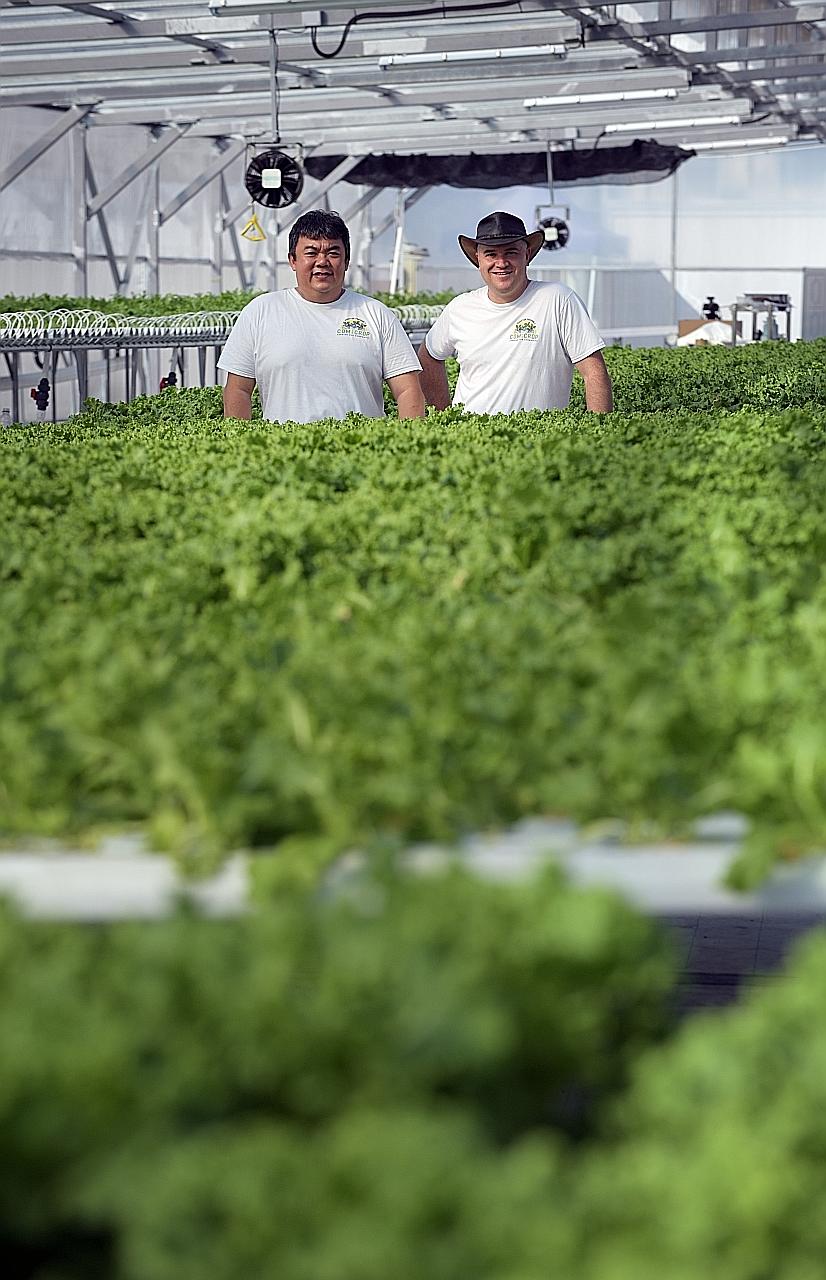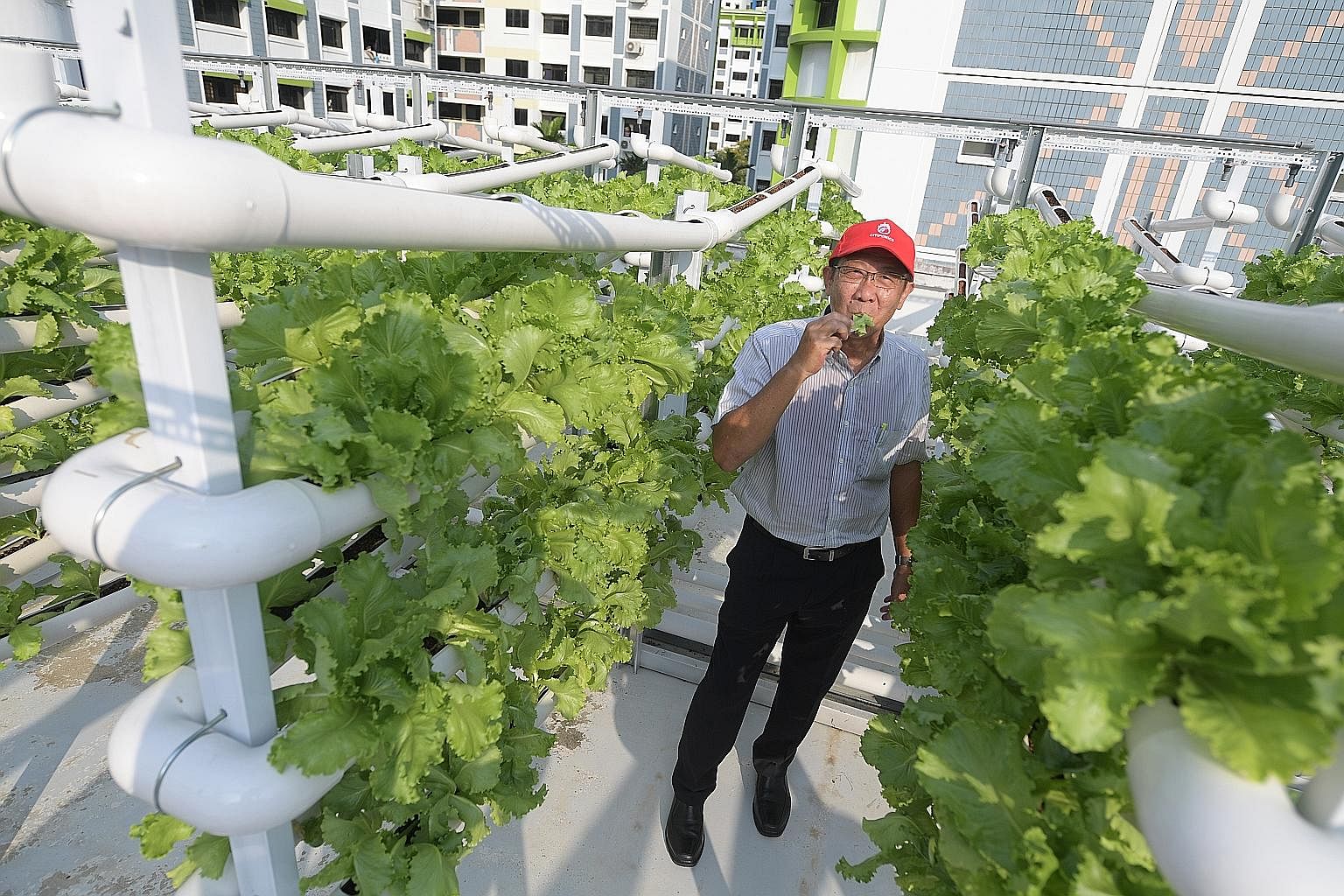Science Talk
Feeding cities of the future
Singapore's journey in urban farming could become a good model for other cities
Sign up now: Get ST's newsletters delivered to your inbox

ComCrop partners Allan Lim (left) and Peter Barber at the urban farm’s greenhouse on the rooftop of an industrial building in Woodlands.
PHOTO: ST FILE
Michael S. Strano
Follow topic:
The Covid-19 pandemic is disrupting food supply chains across the world, but in Singapore, dinner plates are still full thanks to strategic moves by the Government to diversify food sources and build up local agricultural capabilities.
Here, where 90 per cent of food is imported, the target is that by 2030, we will produce 30 per cent of our nutritional needs locally - this is known as the "30 by 30" goal.
Visit any supermarket here and you will see an array of delicious, locally grown vegetables and herbs, fresh seafood, and eggs with different properties, such as those with less cholesterol or higher omega fatty acid content, all produced in one of the most densely populated cities in the world.
Advances in urban farming have allowed us to increasingly utilise our limited land area and cultivate far more yield per square metre than in traditional farmlands.
Our continued efforts to address this issue will turn a vulnerability into a strength.
Singapore's journey in urban farming could become a good model for cities around the world amid a growing population and an increasing demand for food, which will be more apparent in city centres due to urban migration.
Just like how the country has addressed its water needs and now provides leading water management and treatment technologies globally, it could do the same with next-generation technologies and expertise developed for urban farming.
THE NEXT DECADE
Getting to 30 per cent self-sufficiency in less than a decade is a massive task, but it is not impossible.
The Government and stakeholders are working to create opportunities in the agricultural and agritech industry - making more spaces available for urban farming, fostering research and development, and offering new educational programmes.
I lead a team that has been making breakthroughs in the knowledge and technology we need to get there on time.
-
ABOUT THE WRITER
Professor Michael S. Strano is the co-lead principal investigator of Disruptive and Sustainable Technologies for Agricultural Precision at the Singapore MIT-Alliance for Research and Technology, which is the Massachusetts Institute of Technology's (MIT) research enterprise in Singapore. Concurrently, he serves as the Carbon P. Dubbs Professor in the chemical engineering department at MIT. His research focuses on biomolecule and nanoparticle interactions and the surface chemistry of low-dimensional systems, nanoelectronics, nanoparticle separations, and applications of vibrational spectroscopy to nanotechnology.
The Disruptive and Sustainable Technologies for Agricultural Precision (Distap) research group that I manage is one of five interdisciplinary research groups at the Singapore-MIT Alliance for Research and Technology, the Massachusetts Institute of Technology's (MIT) research enterprise in Singapore.
It is a collaboration between researchers at MIT and Singapore-based leading institutions such as the Temasek Life Sciences Laboratory.
Distap looks at how to make tools that can help manufacture crops in a new way, taking a biological engineer's view of plants as a complex machine. It brings together scientists from a wide range of disciplines, from chemical engineering to plant and microbial biology to electrical engineering, to work on complex interdisciplinary issues.
The vision is for agriculture to go the same way as manufacturing in Singapore, by embracing data and developing technology to control the production process.
AN URBAN FARM ON EVERY ROOF
The future for Singapore is that of an urban garden. Its benefits will be more than just productive green spaces that provide fresh produce for all; it will also contribute to better air quality and personal well-being, and the fight against climate change.
Imagine buying a sandwich at a farmer's market and finding that the kale in it has just been picked on the 57th floor of the building at the end of the road - local, organic and farm fresh. We still have a long way to go before we get there, but we have taken huge strides and continue to do so.
Recently, we developed new technologies to "decode" how plants communicate internally, particularly about the stress they are experiencing. Plants send chemical waves that have the type of stress encoded within them.
Now, for the first time, using Raman spectroscopy - which uses laser light pointed at the plant, we can read these signals from the plants. The light that scatters off provides a fingerprint of a plant's health and reveals detailed information about the plant, telling us if it is receiving too much heat or light, or if it had been injured by a predator biting it.
These findings will help us decide on the fly how to improve conditions by promoting or reducing levels of stress in the crops, essentially meaning that we can attempt to control how plants grow.
This has been a dream for the urban farmer for quite some time. But the limitation has always been having sensors that can give a detailed biochemical portrait of crops.
At the moment, our team is pioneering handheld devices that can provide information that allows farmers to see what is happening deep inside a plant.
MORE YIELD, LESS SPACE
For urban farming to achieve any scale, it needs plants to grow at a very high density. The trouble is, some of them do not do very well when close together. This is called the shade effect and is prompted by a plant's desire to grow more quickly than its neighbours.
We would like to breed plants that can grow in close proximity and consume the optimal amount of nutrients. This will help increase productivity and save costs.
Raman and nanosensor technologies developed at Distap will be able to tell if plants are feeling crowded, and can detect biochemical traits such as shade avoidance, to identify which plants grow well together.
An aim of precision agriculture is also to eliminate excess nutrient consumption by a plant, which results in the pollution of aquatic ecosystems through run-off and infiltration into the water table, and the wastage of nutrients.

Mr Teo Hwa Kok, chairman of Citiponics, at the company’s rooftop farm in Jurong. Such urban farms will help Singapore to work towards its “30 by 30” goal of producing 30 per cent of the country’s nutritional needs locally by 2030.
ST FILE PHOTOS
Technologies in precision agriculture will help to eliminate this excess by delivering nutrients such as fertilisers precisely.
Water bodies that are overly enriched with minerals and nutrients encourage excessive growth of algae, resulting in oxygen depletion. One example of what could happen is an algal bloom, which blocks sunlight from reaching other organisms and may secrete toxins into the water, damaging aquaculture.
We also have sensors that can help us understand how plants interact with each other.
When they communicate, plants release molecules into the air that are received by other plants. We are making sensors that, for the first time, allow us to intercept this communication, bringing us closer to being able to engineer optimal growth conditions to improve productivity continuously.
We hope that as these and other breakthroughs develop over the next decade, the real difference Singaporeans will notice will not simply be hundreds of vertical farms and fresh vegetables on the menu at cafes. What they will also enjoy is cheaper, more nutritious food, with items that can be tailor-made to suit society's health needs.
Produce will need less transport, and there will be less food waste. Less time will be needed for food to hit the shelves, it will have a better environmental footprint, and be fresher and taste better.
The simplicity of a local supply chain also offers a higher level of food security, especially if there are import shortages. This is exactly what Singapore is trying to hedge against by making food security and better nutrition its priority.
Singaporeans have ventured into urban farming with reasonable success, but we need more of them to do so for a substantive impact on food supply and security.
More support and awareness of local urban farmers and their produce, the training of budding farmers, rapid adoption of digital technologies by everyone in the industry, and further advancements in agriculture technology, alongside government efforts, will contribute to making urban farming an attractive profession here.
A whole-of-country effort towards achieving the "30 by 30" goal, especially in this unprecedented time, will continue to uncover opportunities for the agricultural industry that will make this future a reality.

